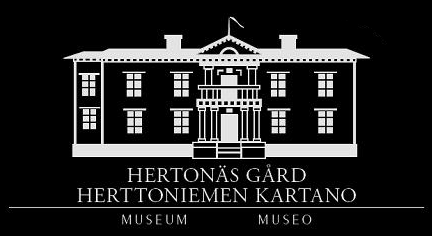
The main buildning of Hertonäs Manor derives from the 18th C. SOV.
The present main buildning of Hertonäs Manor got its new look in 1815, as Carl Olof Cronstedt had acquired the manor and wanted to give it a fashionable exterior. The facade was planned by architect Pehr Granstedt, who also designed many stonehouses in Helsinki at this time that gave the city its imperial style.
The former main buildning was situated further south and it was a wooden buildning in two floors painted red on the exterior. North of this buildning a stonehouse was erected and called ”Brännhuset”, due to the fact that it had ovens for burning clay objects in its cellars.
How was the factory founded? During the time when the manor was owned by the officer Bengt von Spången a factory for making fajance was established here (”en Fabrique till förfärdigande af oäckta Porcellainer”). The permit was given 26th May 1762 and a company was formed with 30 shares – von Spången owned a third of these shares himself. Other shareowneres were prominent nobles and burghers from the nearby city of Helsinki such as Augustin Ehrensvärd and Johan Sederholm. A factory was thus erected on the so called Jägarbacken. Johan Sederholm bought the manor later on, but still maintained the factory.
As Cronstedt became lord of the manor he changed the factory’s stonehouse in to a new main buildning with two floors. The factory still continued to work in the area until 1845. In 2005-07 archaeological excavations were undertaken next to the buildning and some finds of red clay objects were made. Tanja Rönkkö has made a master’s thesis on the ceramics and she claims the objects consist of typical tableware of that period and other things such as rooftiles of red clay. Did they sell the ceramics to the growing city of Helsinki? Probably, claims Rönkkö, and at least it is known that some vessels were brought to the market in the city in 1793.An oven still actually remains in the cellar of the main buildning.
Did this sound interesting? Read more in Rönkkö’s thesis or in our work of history:
Backman, Sigbritt 2016: Hertonäs gård. Från säterier till museum. Svenska Odlingens vänner i Helsinge r.f.: Helsingfors.
Rönkkö, Tanja 2012: PIXE-analyysin käyttö arkeologisten keramiikka-aineiston tutkimuksessa. Tapaustutkimuksena Herttoniemen keramiikkatehdas (1762-1845). Pro gradu-tutkielma, arkeologia. Helsingin yliopisto. Unpublished.
